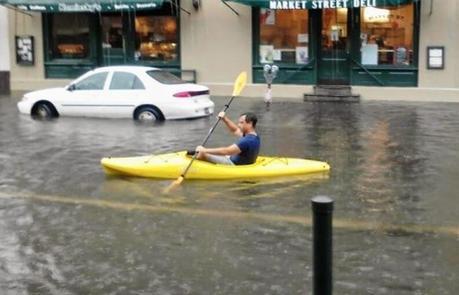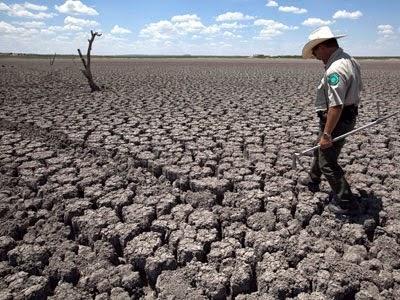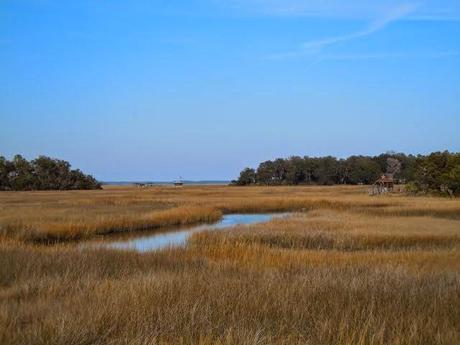Lindsay Koob
Charleston City Paper , September 12, 2007

Market Street, Downtown Charleston S.C. in 2012
Imagine the year is 2107, and you're a tourist in Charleston. But instead of a horse-drawn carriage, you're cruising down what used to be Broad Street in a slow-moving tour boat. The water's nine feet deep, and it's only just past low tide. It's high summer, and the base temperature outside your enclosed, climate-controlled boat is pushing 105 degrees Fahrenheit, not counting the 20-degree heat index. The boat drifts past the ruins of St. Michael's Church, with its gaping, glass-toothed windows and collapsed steeple, as the tour guide drones on about its rich history and the last services held there back in 2053 — the church's 300th anniversary — before the rising waters drove its last parishioners to higher ground. The guide reminds you of the great global climate change exodus that began in earnest that decade, with nearly a billion refugees from coastal regions everywhere on top of untold millions of climate-related deaths.As historic pre-flood photos flash across your seat's video screen, the guide recounts the city's valiant struggle against the ever-rising tide: all the elevated roads, storm sewers, massive pumping systems, canals, and seawalls. And for awhile, they kept pace, that is until the 2040s, when the burgeoning collapse of polar ice sheets drove sea levels to rise more than half a meter per decade. Then in 2046, mega-hurricane Jonah scored a direct hit, devastating the city. The last state and federal insurance props fizzled out, the tax base withered, support and service infrastructures ground to a halt, and the city's economy collapsed. The mega-bucks needed to wall off the sea simply weren't there. By 2050 Charleston had become a half-drowned ghost town.
Since you embarked on your boat tour of sunken Charleston, you haven't seen a seabird all day, and you ask the guide why. He explains that nobody's seen a pelican or a seagull in 40 years, since the marshes drowned. He reminds you that the seas are practically sterile — too acidic and warm to support most sea life — while most of the world's coral reefs are dead. Even the plankton are nearly gone.
By now, you've turned onto the East Bay Canal, passing by the half-collapsed shell of the old Custom House. The water reaches almost to the top of the front steps. The tour ends, and the boat picks up speed, heading out from the sunken city into open water, under the old Ravenel Bridge — now a bridge to nowhere. At least something around here survived intact. Too bad the beautiful old town didn't.

Sure, it's a chilling scenario — but not as far-fetched as you might imagine. It wouldn't be the first time the Lowcountry's been underwater. Just a few weeks back, they found a primeval sea-turtle fossil in a Summerville ditch, and you can dig up ancient petrified sharks' teeth and other marine fossils everywhere along the coastal plain. If only it was geologic time we were dealing with. But now we are learning that our unchecked energy consumption — led by manufacturing, consumerism, and plain old convenience — has compressed eons of climate change into mere centuries, or perhaps even decades. And the heat is on.
Climate Change – Where We Stand
Fifty years ago, nobody listened to the first warnings about pollution-induced global warming and its consequences. But lately, credible scientific evidence has steadily mounted, and what was once theory — or the sky-is-falling cries of a few environmentally-minded Chicken Littles — is now coming true. The United Nations' four-part Intergovernmental Panel on Climate Change (IPCC) report on global warming offers the most credible global confluence of scientific findings and opinion to date (www.ipcc.ch). It zeroes straight in on our wasteful consumption of fossil fuels as the certain cause of our woes.
And the world keeps getting hotter, thanks mostly to our cars and power plants and the vast volumes of greenhouse gases they emit. Yet we still continue to stoke the very atmospheric cooker we're now stewing in. And here, in the land of the figuratively free and the home of the Hummer, we're the world's greediest energy gluttons, gobbling up more fossil fuels and farting out more greenhouse gases than any other nation (though China's catching up fast). And greenhouse gases just don't go away either; most of what we spewed out a century ago is still here and will remain with us for centuries to come. At this point, we can only hope to slow it down enough to avoid the worst of the many possible consequences.
Despite the fairly conservative IPCC predictions, some of our leading scientists are telling us that we're teetering on the brink of self-inflicted climate disaster. Unless drastic action to curtail emissions is taken globally — and soon — rapidly rising atmospheric temperatures (like 6 degrees Fahrenheit) are inevitable by 2100. This in turn will increase oceanic evaporation, boosting torrential rains and flooding in many parts of the world. The higher temps will also dry out topsoils worldwide, spreading drought and deforestation and causing more wildfires.

On land, hotter weather will also mean the disruption of seasonal patterns, destroyed habitats, and ecological imbalances. Native flora and fauna will migrate elsewhere and be replaced by more tropical species. Even worse, mass extinctions, involving untold thousands of species, are possible. Warmer air will also bring warmer oceans, which in turn will spawn stronger, more frequent storms. The disruption of major oceanic currents also threatens major climate shifts. As the oceans heat up, thermal expansion of seawater alone will certainly cause up to 2 feet of sea level rise by century's end.

If such dire predictions come true, the world can kiss its low-lying coastal regions goodbye: places like Holland, Bangladesh, Shanghai, and Venice — not to mention Manhattan, New Orleans, parts of San Francisco, a big chunk of Florida, and Charleston.
According to Jeremy Weiss and Jonathan Overpeck at the University of Arizona, As the sea level rises, from 2 to 6 METERs, Waters will overtake the Charleston area.
Prospects for Charleston
Let's consider what all this means for us. Charleston lies about eight feet above sea level. Just think about the heavy street flooding we get whenever torrential rains come on top of high tide. Sooner or later, a Category 6 hurricane (hey, they're talking about rising ocean temps making those come true, too) could score a direct hit, and a massive storm surge could sweep away half the city.
Even the IPCC's best-case sea level rise of less than a meter will move our shorelines back many hundreds of feet. And that spells likely doom for all the lavish beachfront mansions — and the fragile barrier islands they precariously cling to. All will inevitably succumb to the encroaching surf, and coastal property values will plummet.
With these increasing risks comes the certainty that property insurance will become a scarce commodity. Owners of coastal homes and businesses are already finding that insurance costs are spiraling out of control. This summer's 35 percent hike in state-supported "wind pool" premium rates was no real surprise.
Allison Dean Love, director of the S.C. Insurance News Service, says, "High insurance expense is simply one of the prices you have to pay for the privilege of living on the coast." Most coastal homeowners, she adds, will need as many as six or seven different policies before they can consider themselves adequately covered. You simply won't be able to depend on insurance being there anymore, she warns. Scott Richardson, the state's insurance director, just found that out the hard way when the coverage on his Hilton Head home wasn't renewed.
And then there's the matter of our glorious beaches. A rise in sea level will also cause further coastal erosion, and it won't be long before we have to accept the fact that it is futile to keep renourishing our disappearing beaches. DHEC reports that, since 1990, keeping our beaches well-sanded and tourist-friendly has cost us $144 million. Meanwhile, the Environmental Protection Agency estimates that the overall cost of keeping beaches up to par could top $9 billion this century.
"There's a limited amount of suitable sand for renourishment," says Chris Marsh, executive director of the Lowcountry Institute. "We can't expect it to be available 30 to 50 years from now."

The National Centers for Coastal Ocean Science's Carol Auer, an oceanographer who works for the organization's Center for Sponsored Coastal Ocean Research, says a rise in sea level poses great risks to our coastal wetlands. She places much of the blame on runaway coastal development, which often pushes right up against tidal creeks and marshlands. Routinely approved construction of docks and protective bulkheads often leaves the marshes no place to go as water levels rise, gradually drowning them. "Bulkheads are one of the worst things people can do to the coastal environment," she says.
Jim Morris, director of the Baruch Institute for Marine and Coastal Science at the University of South Carolina, says Charleston-area marshes seem to be healthier than those around the Georgetown area he regularly studies, due in part to the relatively large volumes of sediment deposited by the Cooper River watershed. He adds that while it's an off-and-on process, South Carolina's marshes seem to be keeping up with the rising sea levels for the time being. He believes that they could "probably handle a rate of sea level rising somewhat less than 1 centimeter per year" — at least for awhile, and in areas where marsh expansion isn't blocked by heavy development.
Despite what some straw-grasping skeptics would have us believe, there is no real good news to report about global warming. Ben Moore, climate and energy project manager of the Coastal Conservation League, says, "After a certain point, there are simply no positive aspects to global warming."
Bottom line: How can we defend ourselves from 6 feet of standing water in our streets? Not many of the folks I've talked to foresee the kind of political will and thus the funds to build the kind of massive, Netherlands-style dikes and pumping systems that will be necessary to stem the tide. That's because the rise in the sea level isn't likely to stop at just a few feet; barriers and pumping systems will have to be continually expanded and strengthened.
That said, something must be done.
Michael Maher and the folks at the Charleston Civic Design Center, a municipal planning agency, have begun developing programs and projects they think will help us cope with global climate changes. These include the Charleston Green Initiative, which promotes a more resource-efficient approach to municipal operations. "Charleston's a canary in the coal mine of global warming," Maher says. He hopes that gives us the chance to "lead the fight against it."
Then there's architect Robert Miller, director of the Clemson Architectural Center in Charleston. He and his students recently completed a truly impressive project that looks at peninsular Charleston at various levels of future sea level rise: 1, 3, 6, and 12 feet. (The project will be unveiled at the College of Charleston library sometime after the new year.) Various measures designed to deal with each of these successive water levels are then explored. These include fairly simple measures at the low end, like marsh expansion along the city's western shore, and the creation of water retention parks where storm runoff and tidal flooding can be contained until it can be pumped away.
Then, as projected sea levels rise, so does the sophistication, and expense, of the proposed fixes. The construction of elevated roadways, water-absorbing pervious pavement, seawalls, and canals are all explored by Miller and his crew. The ultimate fixes occur once the sea hits the 12-foot level: if that happens, either a walled-city approach that protects only the peninsula or a massive harbor-front levee that will also save surrounding areas like West Ashley and Mt. Pleasant, complete with a system of locks that will permit continued shipping traffic. "At that point," Miller says, "Charleston will be like another New Orleans: an entire metropolitan area lying well below sea level." But who will pick up the mega-billion price tag?
Sure enough, there remain far more questions than answers at this point. And since we, the people, don't yet take the global warming threat seriously, most related research programs remain seriously underfunded, and therefore ineffective. And we're not likely to wake up until after we suffer several painful black eyes at the hands of poor, abused Mother Nature — or a mortal blow to our pocketbooks. Major policy change is seldom inspired by altruism.
______________________________________________
In the seven years since this article was written, CO2 concentrations in the atmosphere have exceeded 400 ppm -- levels unprecedented in recorded human history. China has already overtaken the U.S. in emissions, and the West Antarctic Ice Sheet has started a now unstoppable collapse, with an estimated sea level impact of 12 ft by 2100. Meanwhile, Republicans in Congress are holding hearings to stop the EPA from issuing new regulations on greenhouse gas emissions.

